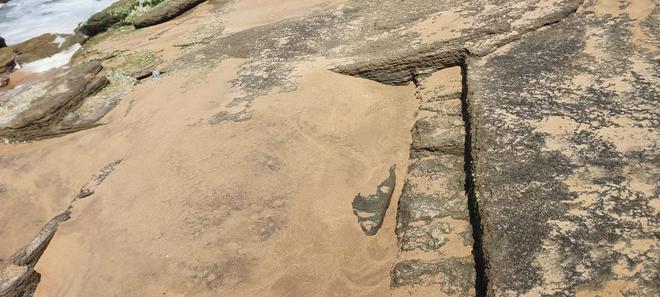An ancient beach rock quarry in Kovalam, a coastal village, near Kanniyakumari, that is believed to have supplied sea rocks for local use and for the construction of a fort located between Kanniyakumari and Kadukkarai, was discovered recently.
A team led by V. Selvakumar, Head of the Department of Maritime History and Marine Archaeology, and Coordinator, Centre for Indian Ocean Studies, Tamil University, Thanjavur visited the spot and studied the quarry. Samples of the rocks have been sent to a local laboratory for further studies.
“The quarry was exposed when the sea receded, and a local photographer and history-enthusiast, M. Faizal, spotted it. We immediately informed Prof Selvakumar,” said Chenthee Natarajan, managing director of Chembavalam Aaiyuthalam Arakattalai.

According to the expert team headed by Prof Selvakumar, the rock at the quarry was basically calcareous sandstone, with the inclusions of shells and sand particles. “This is sandstone formation developed due to the compression of beach sand and other metamorphic factors for several thousands of years. These rocks have been used for different types of construction activity in this region,” he said.
In some areas of the quarry, the team found the stone blocks cut into the shape of bricks. These chisel marks were seen at several places in the quarry. The method adopted at this quarry, seems to have been similar to that of laterite quarrying activities. Each block is marked in situ, and then the blocks are carved and lifted, Prof Selvakumar explained.
“Our observations revealed that the quarrying was not for any residential construction. Large-scale quarrying could have taken place only after the 15th century, when forts were built on a large scale. The precise date of the quarry is not known,” said Mr. Chenthee.
Parts of an old fortification wall, believed to have been constructed as part of a fort in the 18th century, between Kadukkarai near the Western Ghats and Kanniyakumari near the coast, to prevent invasions from the east, still exist. While the fort is believed to have been constructed by Wayanad king Marthanda Varma, Mr. Chenthee is of the opinion that it must have been constructed by Karthikai Thirunal (1758-1798). British officer Colonel St. Leger destroyed this fort in 1806 near Aralvaimozhi.
Though damaged over years, the structures still remain intact in some places. “Traces of the bastions/watch towers and walls associated with the fortification are found at four sites along the national highway up to Kottaram, and include the wall near the Subramanya temple. At some places near the coast, the wall is preserved for more than 10 feet,” said Mr. Chenthee and stressed the need to preserve these structures. He has also written to Chief Minister M.K. Stalin to take steps in this regard.







